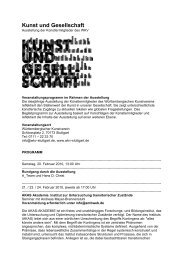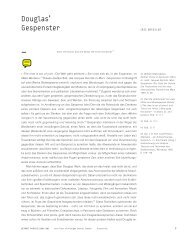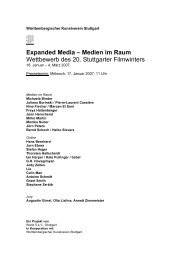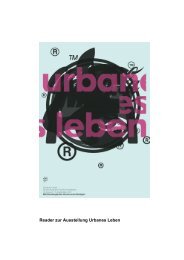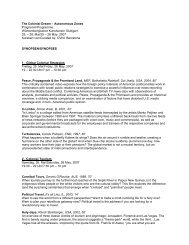English Texts
English Texts
English Texts
Create successful ePaper yourself
Turn your PDF publications into a flip-book with our unique Google optimized e-Paper software.
and which will end up destroying the very gnoseological possibilities<br />
of the archive, for all technology comes to its aid, on the basis of<br />
trying to grasp everything, that ‘mal d’archive’ is particularly<br />
crystallised in the archives of disasters, wars, violence. Opening<br />
the archive like that, exposing it, making it circulate is a way of<br />
looking for those traces, of including those vestiges – of introducing<br />
what cannot be spoken of – yet keeping the archive ‘free of all<br />
evil’. The ‘machine’ proposed, the cinematic gesture thus works<br />
as a gag, according to the brilliant attribution proposed in this<br />
long quotation from Agamben: ‘By having the gesture and not the<br />
image as its centre, the cinema belongs essentially to the order<br />
of ethics and politics (and not simply aesthetics). In that sense the<br />
gesture is the communication of a communicability. It has really<br />
nothing to say, because what it shows is the being-in-language<br />
of man as pure mediality. But since being-in-language is not<br />
something that can be uttered in propositions, the gesture is always,<br />
in essence, the gesture of not managing to find language, it is<br />
always a gag, in the true meaning of the term, which most of all<br />
indicates something put in the mouth to prevent the person from<br />
speaking, and then the actor’s improvisation to fill a blank in the<br />
memory or an inability to speak. Hence not only the proximity<br />
between gesture and philosophy, but also between philosophy<br />
and film. The essential ‘mutism’ of film (which has nothing to do<br />
with the presence or absence of a soundtrack) is, like the mutism<br />
of philosophy, an exhibition of the being-in-language of man, pure<br />
gesture. Wittgenstein’s definition of the mystical as the showing of<br />
what cannot be said is literally a gag definition. And any great<br />
philosophical text is the gag exhibited by language itself, beingin-language<br />
itself as a gigantic gap in the memory, an incurable<br />
defect of the word.’ That transcendence of the gag – a kind of<br />
metaphysics of the joke – triggers the classification system of F.X.<br />
We understand techniques of the gag to be the whole modern<br />
repertoire of art forms, from homophony to chance, from the<br />
readymade to the construction of situations.<br />
That is where Marcel Broodthaers managed to understand<br />
the archive, the museum, the catalogue like nobody else, not<br />
only making a criticism of the straight discourse that always sustains<br />
it, not only questioning the closed order of the world which<br />
any archive represents, not only torpedoing the water line of<br />
the knowledge project of the Enlightenment which any archive<br />
represents, but in the end what Marcel Broodthaers has expounded<br />
is the only way the archive, as a model of everything that has<br />
been indicated, as an example of the modern project of knowledge<br />
of the world, can survive. And he did so through the gag, through<br />
the transformation of the archive into staging, choreography,<br />
dramaturgy, cinematography. Through the theatricalisation of<br />
the archive, he managed to uproot it from the modern project,<br />
without it losing its critical effectiveness.<br />
Indeed, Marcel Broodthaers may be the artist who, with his<br />
fictitious museum, has best demonstrated the impossibility of<br />
classification, and the violence against reality it supposes. And it is<br />
precisely through fiction that he in turn has managed to unmask the<br />
conditions of production of meaning and representation, establishing<br />
the archive and the collection as the place for structuring discourse,<br />
regardless of its real existence.<br />
How more precisely does that symbolic machine, generator<br />
of fictions, which is F.X. Archive work? And, most of all, what does<br />
it aim to achieve?<br />
Here I am going to reproduce Machado’s well-known definition<br />
of Jorge Meneses’ ‘ballad machine’, an artefact capable of<br />
composing the songs of a human group, of a people, of the crowds.<br />
I take the book and read: ‘In the prologue to his Coplas mecánicas<br />
Mairena praises Meneses’ artifice. According to Mairena, the poetic<br />
hurdy-gurdy is a means, among others, of rationalising the lyric,<br />
without lapsing into the conceptual Baroque. The maxim, reflection<br />
or aphorism contained in his coplas are inevitably attached to<br />
a human emotion. The poet, inventor and manipulator of the<br />
mechanical artifice is an investigator and collector of elemental<br />
feelings; a ‘folklorist’, in his way, and an impassive creator of<br />
popular songs, without ever lapsing into a ‘pastiche’ of the popular.<br />
It dispenses with his own meaning, but notes that of its neighbour<br />
and recognises it in itself as a human feeling (when he notices it<br />
objectified in his apparatus). His apparatus does not use padding<br />
or pedantry, and can still be a fertile source of surprises, recording<br />
strange emotive phenomena. Naturally, its value, like that of other<br />
mechanical inventions, is more didactic and educational than<br />
aesthetic. The ballad machine, in short, can entertain the masses<br />
and initiate them into the expression of their own feeling whilst<br />
the new poets, the singers of a new sentimentality, arrive. That<br />
last fragment is where Machado’s position is shown most clearly<br />
– the new sentimentality – which I think is different from Mairena’s<br />
and that of the young Meneses. We may suppose that for the<br />
‘inventor’ of the machine, the ‘conceptual Baroque’, the risks<br />
of padding and pedantry, pedagogy and didacticism, the<br />
entertainment of the masses and their initiation into a feeling of<br />
their own are not handicaps, but a lucid diagnosis of our time.<br />
I hope that its operation, at least its ideal operation, will be what<br />
Zizek describes for the acoustomatic voice, in a personal reading<br />
of Lacan. Zizek gives as examples the eponymous title music from<br />
two films: Brazil, as used by Terry Gilliam in his film, and Lili<br />
Marlene, the theme song of the film by Rainer Weiner Fassbinder.<br />
In both films the song invades reality in a crushing, totalitarian<br />
manner and becomes the only element that makes that reality<br />
bearable. It is the same observation made by Gilles Deleuze<br />
about the capacity for fascination and the Fascism implicit in the<br />
music of Richard Wagner and the way it is overcome in the films<br />
of Luis Buñuel. Or Guy Debord when he goes beyond nostalgia<br />
by reclaiming the ‘red’ anthems of the Spanish Civil War, since<br />
what were anthems are now joyful songs of defeat.<br />
In short, these are mechanisms that overcome the dogmatic,<br />
acritical, spectacular and totalitarian ideas implicit in a world<br />
dominated by aesthetics and the fascination of art, their main<br />
soundtrack.<br />
Exteriority of the Archive<br />
From its creation in the late nineties, F.X. Archive has been shown<br />
in many ways. It has been presented at exhibitions, in publications,<br />
lectures, pages for free circulation, films and participation in public<br />
or historiographic debates. There had even been some attempts to turn<br />
it into a monument, which I suppose the logic of the archive itself<br />
has deposed. How have the contents of F.X. Archive circulated in<br />
academic or artistic circles? And how is it shown?<br />
The idea is that F.X. Archive should work like a public institution,<br />
with one unusual feature. The centre of its works often runs into<br />
the surpluses of the sacred, with ‘effects’ that go beyond semiotics,<br />
with everything Agamben locates in his Homo Sacer cycle ‘on<br />
the outskirts of the city’. As I have said before, a few years ago<br />
I went to a seminar with Agamben, and it would be unfair not to<br />
acknowledge my debt to those days, which were fundamental<br />
for orienting the activities of F.X. Archive. Indeed, once the base of<br />
the archive has been consolidated, the idea is to apply the mechanics<br />
of it more dynamically in spheres closer to the present, immediate<br />
applications of these archaeologies. Which does not mean that it<br />
abandons the documentary dimension, though there is something<br />
of everything.<br />
Naturally, in many cases those applications respond to demands<br />
that have arisen from effects parallel to the project. For example,<br />
taking part in debates, spoken and written, around that aberrant<br />
idea of the ‘historical memory’, an oxymoron which has half of<br />
Spain raising corpses from the war that followed the coup d’état<br />
in 1936. F.X. Archive, as an impugnation of history, requires<br />
approaches of other kinds in which the melancholy salvaging of<br />
722 <strong>English</strong> <strong>Texts</strong>



